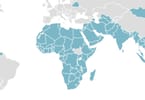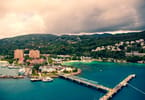Typhoon Halong continues to barrel toward Japan, where lives and property will be severely threatened.
The strength of Halong is expected to be equivalent to that of a strong Category 1 or a minimal Category 2 hurricane as it sideswipes Kyushu Saturday local time and slams into western Shikoku Saturday evening.
Maximum sustained winds at that time will be 135 to 160 kph (85 to 100 mph).
The dangerous typhoon will impact Japan much sooner.
While the outer rain bands and winds graze Okinawa and Kadena Air Base, rain, wind and pounding surf will increase from south to north across the rest of the Ryukyu Islands through Friday night.
Conditions will then deteriorate in a similar fashion across Kyushu, Shikoku and western Honshu Friday night through Saturday evening as Halong approaches, then crosses mainland Japan.
Eastern Kyushu, Shikoku and western Honshu are bracing for the worst of Halong with widespread flooding rain, damaging winds and an inundating storm surge.
Residents should be finalizing the necessary precautions and heed all evacuation orders in advance of dangerous Halong.
Rainfall amounts will top 150 mm (6 inches) with widespread wind gusts between 95 and 130 kph (60 and 80 mph). Destructive wind gusts between 130 and 160 kph (80 and 100 mph) will slam the southern coasts of Shikoku and western Honshu (in the vicinity of Fukuyama and Okayama).
If Halong moves onshore as a Category 2 hurricane, wind gusts to 175 kph (110 mph) are possible along the coast just east of its landfall site.
The torrential rain from Halong can alone cause severe flooding and mudslides. However, recent heavy rain from Tropical Storm Nakri and a stalled frontal boundary have exacerbated the danger.
One location in Kochi Prefecture measured a record 1,186 mm (46.69 inches) in 72 hours, ending on Tuesday, according to information from the Japan Meteorological Agency.
Earlier in the week, AccuWeather.com Meteorologist Eric Leister reported that Nakri brought 250-500 mm (10-20 inches) of rain to some places in Kyushu and Shikoku, according to observation sites across these islands. Multiple locations received more than 10 inches within a single day.
Tokyo will escape Halong’s worst but will still be subject to 25 to 50 mm (1 to 2 inches) of rain and wind gusts to 80 kph (50 mph) over the weekend. The strongest winds will howl Sunday and could cause sporadic power outages and tree damage.
Later in the weekend, western Japan will dry out as Halong tracks through the Sea of Japan and some rain and gusty winds spread across northern Japanese islands of Honshu and Hokkaido.
Halong should then slam into Russia’s Maritime Territory on Monday, unleashing flooding rain and damaging winds. The strongest wind gusts, ranging from 95 to 115 kph (60 to 70 mph), will blast the coastline.
Halong is expected to be a tropical storm or losing its tropical characteristics during its final landfall. Without the necessary fuel of the warm waters, Halong will quickly weaken as it moves northward into Russia with downpours and diminishing winds.
WHAT TO TAKE AWAY FROM THIS ARTICLE:
- The strength of Halong is expected to be equivalent to that of a strong Category 1 or a minimal Category 2 hurricane as it sideswipes Kyushu Saturday local time and slams into western Shikoku Saturday evening.
- Later in the weekend, western Japan will dry out as Halong tracks through the Sea of Japan and some rain and gusty winds spread across northern Japanese islands of Honshu and Hokkaido.
- Tokyo will escape Halong’s worst but will still be subject to 25 to 50 mm (1 to 2 inches) of rain and wind gusts to 80 kph (50 mph) over the weekend.






















